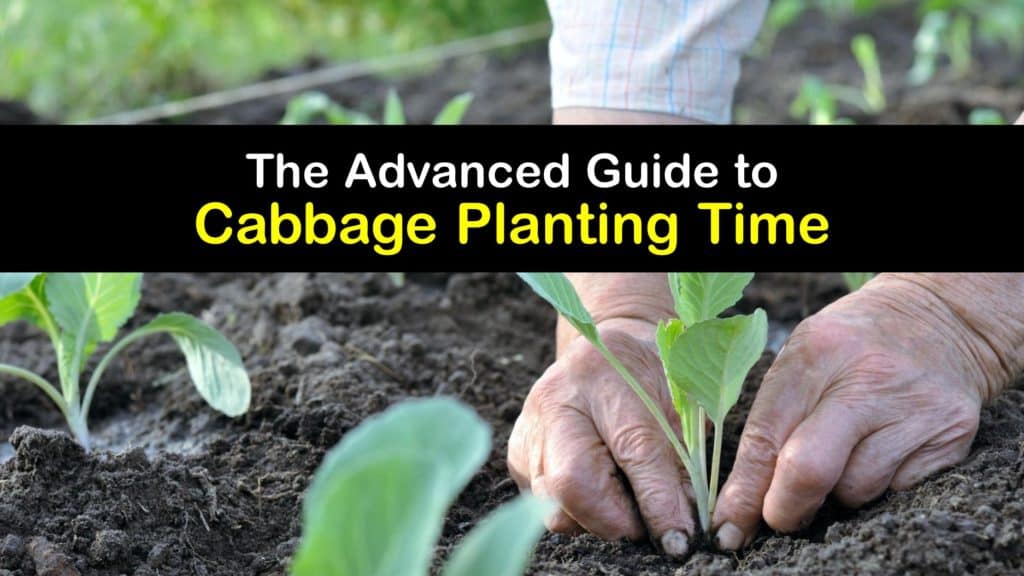Cabbage, known as Brassica oleracea, is a leafy green vegetable growing in tight cabbage heads. There are a variety of cabbage cultivars available, including those with curly leaves or unique coloring. Many growers wonder when to plant cabbage for the best harvest.
There are ornamental cabbage cultivars developed for their appearance rather than their flavor. Knowing the best time to plant cabbage allows growers to take full advantage of the cabbage growing season.
Cabbage is a biennial crop that finishes its life cycle by flowering and going to seed in its second season. However, most gardeners plant it as an annual and harvest it within one growing season to ensure the best quality.

Everything to Know about the Best Time to Plant Cabbage
Cabbage is one of the cool weather cole crops, thriving when planted in the spring after the last frost or in the fall. These heavy feeders enjoy soil rich in organic matter and grow quickly in the cool-season to yield a tasty fall crop.
Cabbages are members of the Brassica family, along with Brussels sprouts, bok choy, kale, and cauliflower. They’re a much-loved vegetable with a range of uses. Understanding when to plant cabbage lets gardeners take advantage of the entire cabbage growing season in their area to grow more veggies.
Though they’re relatively forgiving and straightforward to grow, cabbages are prone to many pests and diseases, so they need careful management to develop a large harvest of high-quality produce.
The best time to plant cabbage varies slightly depending on the garden’s location. Still, specific information is available for each USDA hardiness zone, or growers may contact their local extension office.

When to Plant Cabbage
When the soil is workable, early varieties of cabbage may be planted outdoors a few weeks before the final spring frost. Alternatively, sow cabbage seeds inside six to eight weeks before the last spring frost. Growers may also plant seeds in the garden in late summer for a fall harvest after the warmest weather passes.
Types of Cabbage for the Home Garden
Many different cabbage cultivars are available. Select a cabbage variety based on your goals, preferred flavor, and the growing conditions in your home garden.
Whether you value hardiness or select your cabbage varieties to make the perfect sauerkraut, choosing the most suitable cultivars for your garden is critical.
When to Plant Cabbage Seedlings by USDA Zone
The USDA Plant Hardiness Zones are the ultimate standard for assessing which plants grow in a given environment and which plant species are suitable. Your local cooperative extension is an invaluable source of information if you have a specific query, such as when to plant cabbage in zone 6.
The cooperative extension answers questions like when to plant cabbage in zone 7, identify the best cabbage kinds for your location and even point you in the right direction for buying local cabbage seeds.
If you’re wondering when to plant cabbage in zone 5, contact your local cooperative extension office for further information on everything from hardiness to when cabbage season begins.
How to Plant Cabbage
Plant cabbage seeds in the garden with full sun, fertile soil, and good drainage. Planting near other Brassicas like broccoli attracts the same pests and illnesses so avoid this practice.
Cabbage plants may be grown in containers, but results in a lower yield. Seeds should be planted 1/4 inch deep, and growers should set seedlings one to two feet apart. Larger heads are usually the result of young plants having more room. Avoid transplanting if possible so as not to disturb the cabbage root system.
Plant Care during the Cabbage Growing Season
Cabbage grows best in full sun, or at least six hours of direct sunshine on most days. However, it survives some shade, especially in hotter areas. Cabbage prefers well-drained, organically rich soil. It’s best to incorporate some compost into the soil before planting. Soil pH should be slightly acidic to neutral.
Cabbage demands continuous soil moisture to generate crisp and juicy heads. A sour flavor or malformed heads might arise from inconsistent irrigation. Water as necessary so it remains lightly damp but not saturated.
An inch of water each week should suffice, though if you have fast-draining ground, you may need more – mulch helps retain moisture. Cabbage thrives in warm weather, preferring temperatures of 60 to 65°F. Cover your cabbage plants with row covers to protect them from cold weather if the temperature dips below 45°F.
Harvesting and Storage Cabbages
The length of time it takes for cabbage to mature depends on the variety – it usually takes about 70 days from the time of sowing. The heads are ready to harvest when fully developed, and the outer leaves feel firm to the touch. You risk splitting heads if you keep them out too long before harvesting.
Using a sharp knife, pick up the entire plant. You can also chop the head off at the root, and the plant may produce a second harvest with considerably smaller heads.
Place the head in the shade as soon as possible and bring it indoors. Wrapping the head in plastic and storing it in the refrigerator preserves it for two weeks, or it may be kept for three months in a root cellar at a temperature of 45°F or less. Enjoy your fresh cabbages raw or cooked; wash them thoroughly before eating.
Beware of Cabbage Pests
Unfortunately, cabbage suffers from a variety of issues. The biggest pest threats are cabbage worms and cabbage loopers. They’ll eat their way through the leaves, making holes in the process.
Their tint helps the larvae camouflage with the cabbage, though they’re easy to handpick if you see them. Cabbage may be attacked by slugs, maggots, flea beetles, aphids, and cutworms, too.
Cabbage is susceptible to several fungal diseases, as well, including clubroot, downy mildew, blackleg, and black rot. You cannot do much once your cabbage is contaminated except removing the sick plants.
However, it’s possible to avoid difficulties by choosing disease-resistant types and not planting cabbage in the same area year after year, as fungal spores persist in the soil.
If you’re ready to take advantage of the cabbage growing season, rest assured a fun and productive project lies ahead. Cabbages are easy to plant, generally hardy, and produce a good yield of edible veggies per plant.
This staple leafy green struggles with several pests and diseases, but provided growers stay vigilant in detecting and treating them and meet the moisture requirements, it’s likely to produce a large harvest.
Cabbage does not require trimming in most cases. However, if you see any broken leaves touching the ground, pick and dispose of them. They risk introducing pests and illnesses to the plant if left unattended.
You don’t have to worry about overwintering cabbage plants because they’re usually cultivated as an annual. However, if a cold spell is expected before your cabbage crops are ready to harvest, cover them with row covers for some extra protection.

If you enjoyed this article on when to plant cabbage, please share these handy tips for the best time to plant cabbage with your friends and family on Pinterest and Facebook.